As a whiskey enthusiast, I often find myself pondering the longevity of unopened whiskey. It’s only natural to want to preserve the quality and flavor of this cherished spirit. So, how long will whiskey last unopened? Let’s dive into the world of whiskey shelf life and discover the optimal storage conditions for unopened whiskey.
Key Takeaways:
- Unopened whiskey, with an alcohol content of 40% ABV or higher, is considered shelf-stable and can last indefinitely.
- The type of whiskey and storage conditions can affect its shelf life.
- Protecting unopened whiskey from light, temperature fluctuations, and air exposure is crucial in preserving its quality.
- Storing unopened whiskey in a cool and dark place, away from direct sunlight, is recommended.
- Airtight storage and consistent temperature control help extend the lifespan of unopened whiskey.
Contents
- 1 What Is Whiskey?
- 2 Does Whiskey Go Bad?
- 3 How Does Light Impact Whiskey’s Shelf Life?
- 4 How Does Temperature Impact Whiskey Shelf Life?
- 5 How Does Oxidation Impact Whiskey’s Shelf Life?
- 6 How Long Do I Have To Drink an Open Bottle of Whiskey?
- 7 How Does Aging Alcohol Work?
- 8 Tips To Store Whiskey in the Best Conditions
- 9 Conclusion
- 10 FAQ
- 11 Will the Shelf Life of an Opened Whiskey Differ from an Unopened Whiskey?
- 12 Source Links
What Is Whiskey?
Whiskey is one of the five major types of liquor, along with vodka, gin, tequila, and rum.
It is typically made from distilled cereal grains such as rye, wheat, barley, and corn. The whiskey production process involves fermenting the grains, distilling the liquid, and aging it in wooden barrels. The wooden barrels not only provide a vessel for aging, but they also contribute flavors and colors to the whiskey.
Different types of whiskey have their own unique flavor profiles, ranging from nutty and spicy to warm, caramelly, and woodsy. The flavors of whiskey can also be influenced by factors such as the type of grains used, the fermentation process, the duration of aging, and the region of production.
In the world of whiskey, there are various types to explore, each with its distinct qualities:
- Scotch Whisky: Made in Scotland, known for its smoky and peaty flavors.
- Bourbon: A type of American whiskey made primarily from corn, offering sweet and rich flavors.
- Rye Whiskey: Made with at least 51% rye grain, it has a spicier taste compared to other types of whiskey.
- Irish Whiskey: Produced in Ireland, known for its smooth and light character.
- Japanese Whisky: Inspired by Scotch whisky, Japanese whisky is gaining popularity for its complex flavors.
“Whiskey is a fascinating spirit that showcases the creativity and craftsmanship of distillers around the world. From the different types to the intricate production process, there’s always something new to discover and savor.”
Whether you prefer the smoky notes of Scotch whisky, the sweet richness of bourbon, or the spicy kick of rye whiskey, there is a whiskey out there to suit every palate.
The Whiskey Production Process
The whiskey production process involves several key steps, each contributing to the overall flavor and character of the final product:
- Mashing: The grains are ground and mixed with water to create a mash.
- Fermentation: Yeast is added to the mash, fermenting the sugars into alcohol.
- Distillation: The fermented liquid is distilled, separating the alcohol from other impurities.
- Aging: The distilled whiskey is aged in wooden barrels, allowing it to develop its distinct flavors and colors over time.
- Bottling: After aging, the whiskey is filtered, diluted to the desired proof, and bottled for sale.
Each step of the production process plays a crucial role in shaping the final product, ensuring that every sip of whiskey delivers a unique and memorable experience.
| Types of Whiskey | Characteristics |
|---|---|
| Scotch Whisky | Smoky, peaty, and complex flavors |
| Bourbon | Sweet, rich, and full-bodied taste |
| Rye Whiskey | Spicy and robust flavor profile |
| Irish Whiskey | Smooth, light, and approachable |
| Japanese Whisky | Complex and well-balanced flavors |
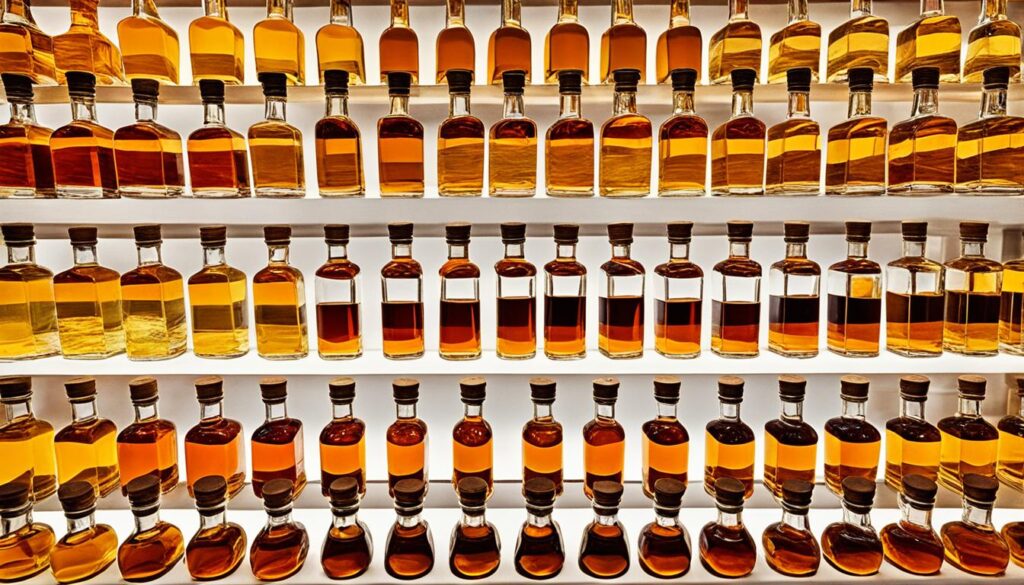
Does Whiskey Go Bad?
Unopened whiskey does not go bad as long as it remains properly sealed and stored. However, once a bottle of whiskey is opened, various factors can impact its quality over time. Exposure to air, sunlight, and extreme temperatures can alter the flavor and alcohol content of whiskey, causing it to go bad.
Why Does Whiskey Go Bad?
When whiskey is exposed to light, it can cause the liquid to lose its color. Temperature changes can also have a negative effect on the flavor compounds in whiskey, degrading its taste. Additionally, oxidation from air exposure can spoil the whiskey, resulting in a deteriorated quality.
“Exposure to air, sunlight, and extreme temperatures can alter the flavor and alcohol content of whiskey, causing it to go bad.”
To understand why whiskey goes bad, it’s important to consider each of these factors individually:
- Light Exposure: When whiskey is exposed to light, particularly sunlight, it can cause the liquid to lose its color over time. This can affect both the aesthetic appeal and the overall experience of enjoying the whiskey.
- Temperature Changes: Extreme temperature fluctuations can impact the flavor compounds present in whiskey. Substantial heat or cold can alter the delicate balance of flavors, resulting in a degraded taste.
- Oxidation: Once a bottle of whiskey is opened, it becomes exposed to air, which leads to oxidation. This process can cause the whiskey to spoil over time, affecting its aroma and taste. Properly sealing the bottle can help slow down the oxidation process.
Preserving the Quality of Whiskey
To extend the lifespan of opened whiskey and preserve its quality, it is important to take certain precautions:
- Store in a cool, dark place: Keeping whiskey away from direct sunlight and extreme temperature fluctuations can help maintain its flavor and aroma. Storing it in a dark cupboard or shelf is ideal.
- Seal the bottle tightly: Minimize air exposure by ensuring the bottle is properly sealed after each use. This can help slow down the oxidation process and preserve the whiskey’s quality for a longer period.
- Consume within a reasonable time frame: Although whiskey does not have a definitive expiration date, it is recommended to consume opened whiskey within two years if it is at least halfway full. The more air in the bottle, the faster the oxidation process occurs. Enjoying whiskey within a reasonable time frame ensures the best possible taste and experience.
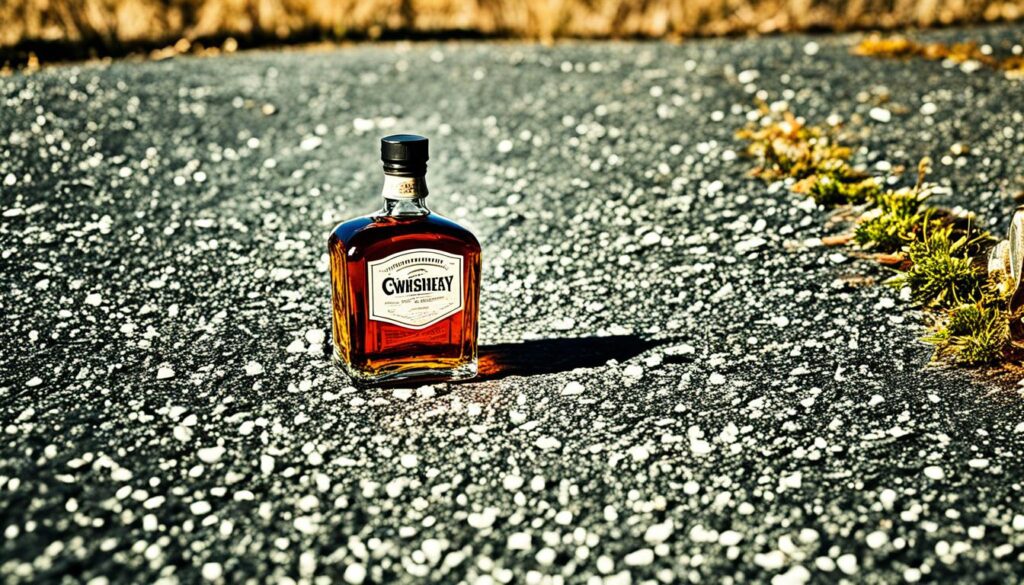
By understanding the factors that contribute to whiskey spoilage, it becomes easier to take the necessary steps in ensuring the longevity of this beloved spirit. Proper storage, minimal air exposure, and mindful consumption can help preserve the quality and flavor profile of whiskey over time.
How Does Light Impact Whiskey’s Shelf Life?
When it comes to preserving the quality of whiskey, light exposure is a crucial factor to consider. Sunlight contains UV rays that can have a detrimental effect on the whiskey, causing it to lose its color and potentially altering its flavor profile. To protect your precious bottles from the harmful effects of light, it’s essential to take certain precautions.
Whiskey bottles are typically made of brown or green glass, which acts as a shield against UV rays, minimizing the light’s impact on the liquid. This is why you’ll rarely see whiskey stored in clear glass bottles. The darker glass helps to block out a significant portion of the harmful sunlight, preserving the integrity of the whiskey for a longer period.
When storing unopened whiskey, it’s important to choose a suitable location that minimizes light exposure. Keeping the bottles in a dark cupboard or shelf will help shield them from direct sunlight. By doing so, you can extend the shelf life of your unopened whiskey and ensure that it retains its original character and quality.
It’s worth noting that while light exposure is a concern for unopened whiskey, it’s even more critical for opened bottles. Once opened, whiskey becomes more vulnerable to the damaging effects of light, air, and other external factors. That’s why it’s essential to consume opened bottles within a reasonable timeframe to ensure an optimal drinking experience.
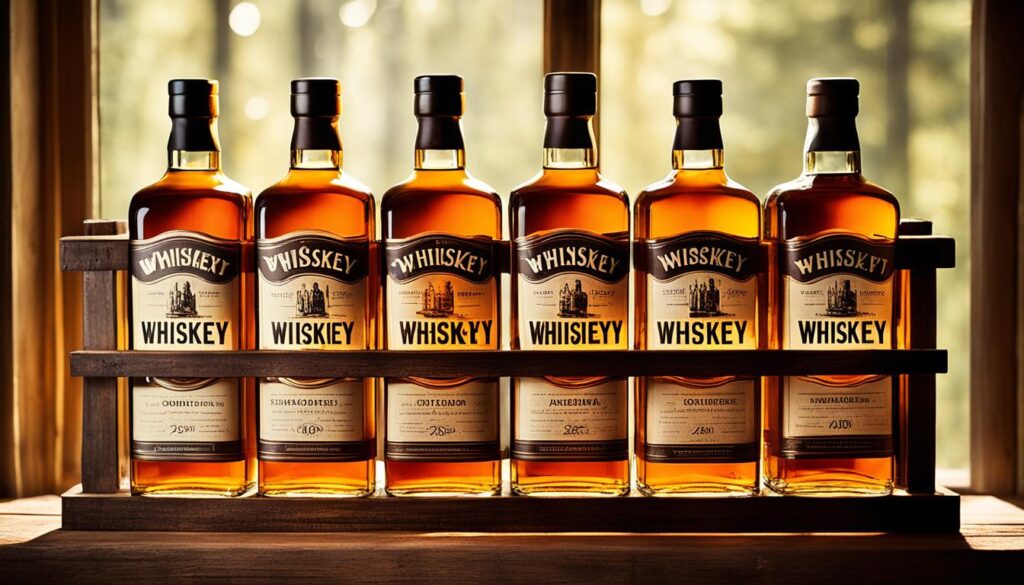
Protecting Whiskey from Light
Here are some practical tips to protect your whiskey from light:
- Store unopened whiskey bottles in a dark cupboard or shelf away from direct sunlight.
- Choose whiskey bottles made of brown or green glass to shield against UV rays.
- Avoid displaying whiskey bottles in areas exposed to excessive light, such as near windows.
- Consider investing in a whiskey cabinet or cellar with controlled lighting conditions.
By taking these simple steps, you can safeguard your whiskey collection from the damaging effects of light, ensuring each sip is as exceptional as the first.
| Light Exposure | Impact on Whiskey |
|---|---|
| Direct sunlight | Causes loss of color in the whiskey |
| UV rays | Potential alteration of flavor profile |
| Whiskey bottles made of brown or green glass | Acts as a shield against UV rays |
| Storing unopened whiskey in a dark cupboard or shelf | Minimizes light exposure and preserves quality |
How Does Temperature Impact Whiskey Shelf Life?
When it comes to storing whiskey, temperature plays a crucial role in preserving its quality and flavor. Temperature swings can have a significant impact on the shelf life of whiskey and can lead to undesirable changes in its taste and aroma. Let’s explore how temperature affects whiskey and how you can ensure optimal storage conditions for your favorite bottle.
The Role of Terpenes in Whiskey
Whiskey owes its rich and complex flavors to the presence of terpenes, aromatic compounds found in many plants and fruits. These terpenes contribute distinct notes of fruits, spices, and herbs, enhancing the overall taste experience. However, temperature fluctuations can alter these delicate compounds, potentially diminishing the whiskey’s flavors and aromas.
Extreme heat can accelerate the breakdown of terpenes, leading to a loss of flavor and complexity. Conversely, cold temperatures can cause these compounds to become less pronounced, resulting in a muted and less enjoyable drinking experience. Therefore, it’s essential to store whiskey in an environment with a relatively consistent temperature to maintain the integrity of its terpene profile.
The Ideal Whiskey Storage Temperature
So what temperature is best for storing whiskey? While personal preferences may vary, a general guideline suggests maintaining a storage temperature of around 70 degrees Fahrenheit (21 degrees Celsius). This moderate temperature helps preserve the delicate balance of flavors and aromas in whiskey, allowing you to savor its full potential with each sip.
It’s important to note that sustained exposure to temperatures above 80 degrees Fahrenheit (26 degrees Celsius) can significantly impact the quality of your whiskey. High heat can speed up chemical reactions, resulting in a hastened deterioration of the whiskey’s character. Therefore, it’s best to avoid storing whiskey in areas prone to excessive heat, such as near radiators or windows.
Taking Precautions to Avoid Temperature Swings
To minimize the negative effects of temperature swings, consider implementing the following storage practices:
- Choose a cool and dark storage location: Find a place in your home that remains relatively cool and away from direct sunlight. A cellar, basement, or a dedicated whiskey cabinet can provide ideal conditions.
- Avoid drastic temperature changes: If possible, keep the storage environment as stable as possible to avoid rapid fluctuations in temperature. Sudden and extreme temperature shifts can shock the whiskey and compromise its qualities.
- Invest in a temperature-controlled storage solution: If you’re a serious whiskey connoisseur, a wine fridge or cellar with adjustable temperature settings can provide optimal conditions for long-term storage.
By following these precautions, you can help extend the shelf life of your whiskey and ensure that each pour delivers the delightful flavors and aromas that make this spirit so remarkable.
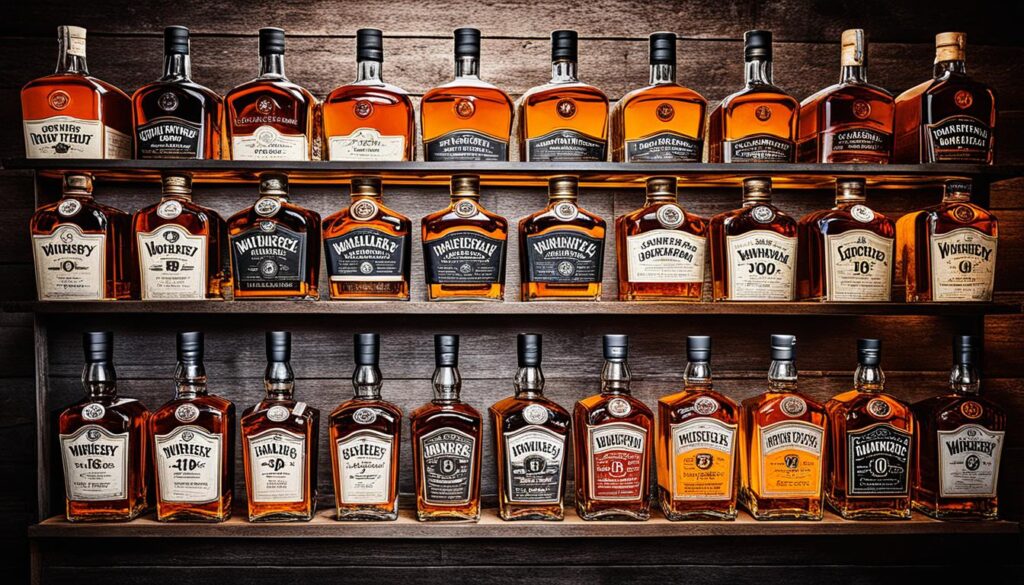
Remember, maintaining a consistent temperature is just one piece of the puzzle when it comes to whiskey storage. In the next section, we’ll explore the impact of oxidation on the shelf life of whiskey and how to minimize its effects. Stay tuned!
How Does Oxidation Impact Whiskey’s Shelf Life?
Oxidation is a major factor in the shelf life of opened whiskey. When a bottle of whiskey is opened, it comes into contact with air, and this exposure to oxygen can cause the whiskey to deteriorate over time. As oxygen reacts with the whiskey’s compounds, it alters the flavor, aroma, and overall quality of the spirit. To ensure your whiskey stays fresh and enjoyable, it’s essential to understand the effects of oxidation and take proper storage measures.
As soon as a bottle is opened, oxygen begins to interact with the whiskey molecules, leading to changes in taste and aroma. The rate of oxidation increases as the bottle is emptied, mainly due to the increased air-to-whiskey ratio. This means that the whiskey remaining in the bottle is more exposed to oxygen, accelerating the spoilage process and diminishing the drinking experience.
To mitigate the impact of oxidation and extend the shelf life of opened whiskey, it is crucial to store the bottle in an airtight manner. Airtight storage prevents additional oxygen from entering the bottle, reducing the rate of oxidation. Here are a few tips to keep in mind:
- Re-seal the bottle tightly after each use.
- Store the whiskey upright to minimize the whiskey’s surface area exposed to air.
- Avoid temperature fluctuations, as they can expedite oxidation.
- Consider using a whiskey pourer or a vacuum sealant to further minimize oxygen exposure.
By following these storage practices, you can help preserve the quality and flavors of your opened whiskey for a longer period. It’s important to note that even with proper storage, oxidation will take place over time. Therefore, it’s recommended to consume the whiskey within a reasonable timeframe to fully enjoy its optimal taste.
An image depicting a properly sealed whiskey bottle with the keyword “whiskey oxidation” is visually appealing and relevant to this section. It highlights the importance of airtight storage in minimizing oxygen exposure and maintaining the quality of whiskey.
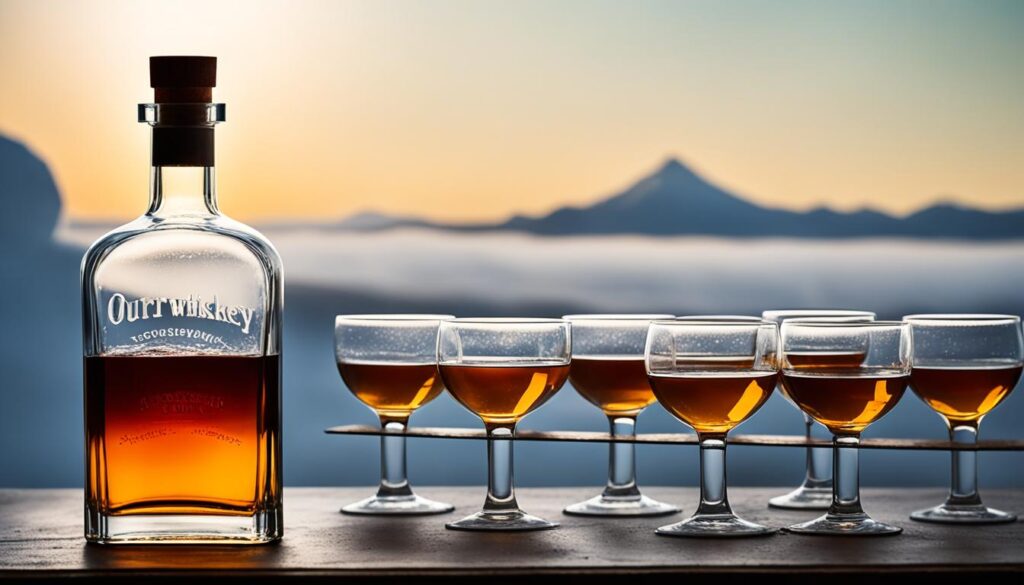
The Effects of Oxidation on Whiskey
Oxidation not only affects the taste and aroma of whiskey but also its appearance. Over time, exposed whiskey may lose its vibrancy and become dull or cloudy in color. The flavors can become mellowed or altered, and the aroma may diminish. Therefore, it’s essential to be mindful of how oxygen exposure can impact the overall drinking experience.
Preserving Your Whiskey’s Freshness
Proper storage and airtight sealing are key to preserving the freshness and quality of your opened whiskey. By minimizing oxygen exposure, you can retain the complex flavors, aromas, and character of the spirit. Remember to reseal the bottle tightly, store it upright, and consider using additional tools or methods to reduce oxygen contact. With these precautions, you can savor your whiskey for an extended period, ensuring each sip is as enjoyable as the first.
How Long Do I Have To Drink an Open Bottle of Whiskey?
Once a bottle of whiskey is opened, it is essential to consider its lifespan and optimal drinking period. The shelf life of an opened bottle of whiskey can be influenced by various factors, including storage conditions and the rate of whiskey oxidation.
For an opened bottle of whiskey that is at least halfway full, it is generally recommended to consume it within two years to enjoy the flavors at their best. The whiskey oxidation rate increases as the bottle is emptied, accelerating the spoilage process.
However, if the bottle is less than halfway full, the optimal drinking period may decrease to six months or less. This shorter timeline is due to increased exposure to air, which speeds up the whiskey oxidation rate and compromises its quality.
It’s important to note that these time frames are general guidelines and can vary depending on the storage conditions and air exposure quality. Factors such as temperature fluctuations, light exposure, and the tightness of the bottle seal can all impact the whiskey’s lifespan once opened.
To ensure the best drinking experience, it is advisable to consume an opened bottle of whiskey within the recommended time frames and store it in airtight containers to minimize air exposure and slow down the whiskey oxidation process.
How Does Aging Alcohol Work?
Aging alcohol, including whiskey, is a fascinating process that takes place in wooden barrels. This aging process is essential for achieving the rich flavors and distinct characteristics that whiskey enthusiasts crave.
When whiskey is placed in a wooden barrel, a transformation begins. The interaction between the whiskey and the wood plays a vital role in the development of flavors and aromas. The whiskey slowly absorbs compounds from the wood, such as tannins, lignins, and vanillin, which contribute to its complex taste profile.
The wooden barrel also serves another important purpose – it acts as a seal, preventing oxidization. This means that the aging process can occur without the whiskey spoiling. The tight grain structure of the wood and the natural swelling and contracting of the barrel create a barrier that keeps air out and allows the whiskey to mature uninterrupted.
“The aging process allows whiskey to evolve, enhancing its flavors and creating a unique drinking experience.” – Whiskey Expert
But the aging process doesn’t stop there. Even after the whiskey leaves the barrel, it can continue to develop and refine its flavors. Distilleries often employ a technique known as the finishing process, where the whiskey is further aged in casks or barrels made from different types of wood. This can include sherry casks, wine barrels, or even barrels made from other spirits like rum or cognac.
During this finishing process, the whiskey interacts with the flavors and residual compounds present in the new wood, adding another layer of complexity to its taste. The duration of the finishing process can vary, but it is carefully managed to ensure the desired flavor balance is achieved.
Overall, the aging process in wooden barrels and the subsequent finishing process play instrumental roles in shaping the final flavor profile of whiskey. From the initial interaction with the wood to the additional maturation in different casks, these processes allow for the control and refinement of the whiskey’s aging journey, producing a diverse range of flavors that whiskey enthusiasts enjoy.
Tips To Store Whiskey in the Best Conditions
When it comes to storing whiskey, the right conditions can make all the difference in preserving its quality and flavor. Whether you’re a whiskey connoisseur or simply want to ensure your favorite bottle stays in optimal condition, these tips will help you protect your whiskey from light, temperature, and air exposure.
Protecting Whiskey from Light
Exposure to light, especially direct sunlight, can have a detrimental effect on whiskey. UV rays can cause the alcohol to lose its color and degrade its quality over time. To safeguard your whiskey from light:
- Store your bottles in a cool, dark place, such as a cupboard or a dedicated whiskey cabinet.
- If your whiskey comes in a box or bottle sleeve, keep it stored in its original packaging to provide an extra layer of protection from light.
Controlling Whiskey Storage Temperature
Temperature fluctuations can also impact the quality of your whiskey. To maintain ideal storage conditions:
- Keep your whiskey away from extreme temperature changes, such as direct heat or freezing temperatures.
- Avoid storing your bottles near appliances or areas that generate heat, such as radiators or ovens.
- Consider using a cellar or wine fridge with controlled temperature and humidity for long-term storage.
Airtight Storage
Oxidation is a common concern when it comes to storing opened whiskey. To minimize air exposure and preserve the flavors of your whiskey:
- Ensure the bottle is tightly sealed after each use to prevent excessive air from entering.
- If your whiskey bottle has a cork stopper, make sure it fits securely and doesn’t allow air leakage.
- Consider using a vacuum seal device to remove excess air from the bottle before resealing it.
By following these tips, you can ensure that your treasured bottle of whiskey remains in top-notch condition, ready to be enjoyed sip by sip. Cheers!
Conclusion
After exploring the factors that affect the shelf life of unopened whisky and the impact of storage conditions on its longevity, it is clear that proper storage is key to preserving unopened whisky for an indefinite period.
By keeping whisky away from light and storing it in a cool, dark place, you can protect it from UV rays that can cause color loss. Additionally, maintaining a consistent temperature around 70 degrees Fahrenheit helps to prevent the alteration of flavor compounds, ensuring that you can enjoy the whisky at its best.
When it comes to opened whisky, oxidation becomes a significant factor in its shelf life. Properly sealing the bottle and minimizing air exposure can help extend the drinking window. It is recommended to consume opened whisky within two years if the bottle is at least halfway full, allowing you to fully appreciate its flavors and aromas.
In conclusion, preserving unopened whisky and enjoying it at its best requires understanding the importance of storage conditions and timely consumption. By following these guidelines, you can savor the rich flavors of whisky for years to come, ensuring a delightful drinking experience every time.
FAQ
How long will unopened whiskey last?
What is whiskey?
Does whiskey go bad?
How does light impact whiskey’s shelf life?
How does temperature impact whiskey shelf life?
How does oxidation impact whiskey’s shelf life?
How long do I have to drink an open bottle of whiskey?
How does aging alcohol work?
What are tips to store whiskey in the best conditions?
How can I enjoy whiskey at its best?
Will the Shelf Life of an Opened Whiskey Differ from an Unopened Whiskey?
Yes, the shelf life of an opened whiskey will differ from an unopened one. To maintain the quality of the whiskey, it’s important to follow the best practices for storing whiskey. Once opened, the whiskey starts to interact with air and deteriorate over time, resulting in changes to its flavor and aroma.